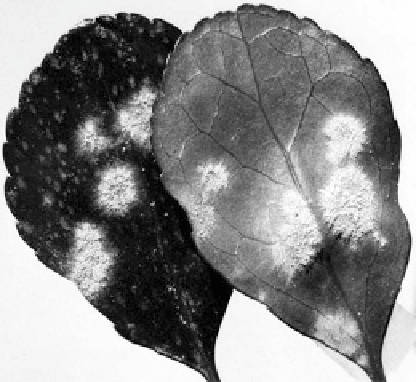Biology Reference
In-Depth Information
intercellular spaces; each of these intercellular
branches or hyphae sends a single haustorium
into the adjacent cell.
Phyllactinia angulata
Powdery Mildew
on
elm.
Phyllactinia corylea (syn.
P angulata
).
Pow-
dery Mildew
of trees, named for the hazelnut or
filbert but prevalent on many other trees and
shrubs, such as amelanchier, ash, barberry,
beach, birch, boxwood, catalpa, chinaberry,
crabapple, currant, blackberry, raspberry, goose-
berry, crape-myrtle, dogwood, buttonbush, chest-
nut, elm, elder, fringe-tree, hawthorn, hickory,
hornbeam, holly, linden, oak, plane trees, quince,
rose, sassafras, tulip-tree, walnut and willow.
Mildew is seldom serious enough on shade trees
to warrant control measures, but in the nursery
dusting with sulfur may be advisable. It is com-
mon on filberts in Oregon, but comes so late in the
season it does not affect yield.
Fig. 4
Powdery Mildew on Euonymus; prevalent in the
South
California. White patches are formed on upper
surface of leaves, the tissue underneath first
a darker, watery green, then losing color, turning
yellowish.
Oidium sp. On greenhouse snapdragons,
a white powdery growth on both leaf surfaces,
sometimes on young stems. Control with
Karathane or sulfur.
Oidium sp. On avocado, occasionally in Flor-
ida, in nurseries or on young trees in shaded
locations. Tips of shoots are killed back; dark
green spots appear on upper leaf surfaces with
white mycelium on the underside. The mildew
can be controlled with lime sulfur. On alfalfa in
Wisconsin.
Oidium sp. On shrub banana in LA.
Oidium sp. On black medic in CA.
Oidium sp. On
Melilotus alba
in FL.
Oidium sp. On poinsettia.
Oidium sp. On tomato.
Oidium sp. On Torena.
Podosphaera
Perithecia globose; one ascus, with eight spores;
appendages dark brown or colorless, dichoto-
mously branched at tip; rarely an extra set of
basal appendages present.
Podosphaera leucotricha
Powdery Mildew
of
apple, also crabapple, pear, quince, photinia. First
noted in Iowa on seedling apples in 1871, this
mildew became more important in orchards when
organic fungicides, ineffective for mildew, were
substituted for sulfur and copper in the apple-scab
schedule. Twigs, foliage, blossoms and fruits
may be disfigured, stunted, deformed or killed.
Gray to white felty patches are formed on leaves,
usually on underside. Leaves are crinkled, curled,
sometimes folded longitudinally and covered
with masses of powdery spores. They soon turn
brittle and die, resulting in decreased yield. The
same powdery growth starts on 1-year twigs, but
in midsummer it is transformed into a brown,
felty covering, in which minute, dark perithecia
are embedded in dense aggregations. Infected
twigs are stunted or killed. The fungus winters
as dormant mycelium on twigs or in buds. Such
buds produce shriveled blossoms and no fruit.
Phyllactinia
Perithecia are large; appendages are lancelike
with a bulbous base. Mycelium does not send
haustoria into epidermal cells of host but forms
special branches that pass through stomata into




